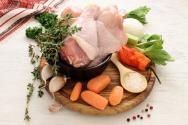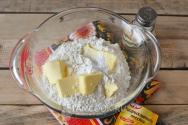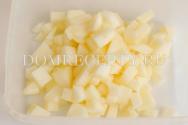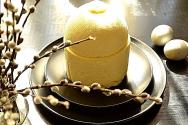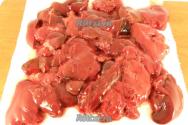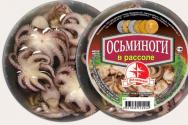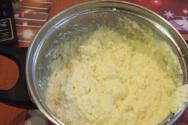How to make custard Easter from milk. Boiled Easter - recipes with and without cottage cheese. Video about how to brew Easter with almonds and raisins from Grandma Emma
Easter is good because it is made from milk. This Easter is not prone to whey leakage and is ready after 12 hours. The good thing is that Easter does not contain raw eggs. After Easter, whey remains, which can be used when baking Easter cakes (instead of milk). Updated recipe (from 2 years ago) under the cat..
General form
Products (milk, butter, eggs, cream..) and whey that has separated, at the almost boiling stage - finished whey. 
Sour cream whipped with eggs and a device for rubbing the whey. 
Easter is good because it is made from milk. This Easter is not prone to leakage of whey and is ready after 12 hours. The good thing is that Easter does not contain raw eggs. After Easter, whey remains, which can be used when baking Easter cakes (instead of milk
The recipe for this Easter has already been posted here, but this recipe has been slightly supplemented with comments on molding and just comments.
On the Internet, a similar recipe can be found under a variety of names, sometimes it’s “cheese”, sometimes it’s “dessert”. In fact, according to people who came from among hereditary priests, this is the recipe used to prepare Easter in the good old days (even before the revolution). Be that as it may, the authors boldly take it upon themselves to claim that this is the best Easter option of all possible).
Prepare in advance:
Butter - 250g, which should be softened (but not melted!).
Powdered sugar - 1 or 1 ½ cups.
Vanilla sugar (vanillin) - a little at all.
Beat 10 eggs with a whisk, without fanaticism, not into foam, just stir thoroughly with a whisk.
Place 1 liter of sour cream in a thick-walled 4 liter saucepan, stir it with a whisk and add eggs while stirring (beating) (also without fanaticism - not a teaspoon per hour)).
Milk - 3 liters (better than country fat milk, of course, or even pasteurized high-fat milk, but with a short shelf life - not from tetrapacks and boxes in which the milk, no matter what the manufacturers promise, is made from powdered milk and is not fermented at all!), pour into stirring sour cream with eggs with a whisk.
Place the pan with the contents on the hob and heat slowly, stirring occasionally with the same whisk. When the whey comes off, pour the contents of the pan into a colander lined with gauze in 2 layers (you must try not to bring the mixture to a boil, the whey comes off at the stage when the mixture is hot, but not boiled).
The whey will actively drain from the curd mass within 30-60 minutes. While the whey is draining, you can gently stir the mass with a wooden spatula (spoon) to speed up the process of whey draining.
Rub the curd mass through a metal sieve (this is a very simple manipulation due to the fact that the mass is fresh and very soft).
Then you should put the mass in a bowl and add softened (not melted, but pre-softened!) butter - 250g, a little vanilla sugar (vanillin) and powdered sugar in the amount of 1 cup (glass volume 250 ml) and stir the whole mass thoroughly. For those who have a sweet tooth, you can use more powdered sugar...
MOLDING
You can mold not only in traditional “pasochny” containers, but also in funnels (lined with gauze), in metal rings (lined with parchment on the sides), drushlags (lined with gauze), using anything - because the whey from this Easter practically does not flow out and Easter is ready in 1 day, unlike Easter made from cottage cheese.
To place Easter on a dish, you need to peel back the Easter gauze from the base, cover it with a dish (plate) and turn the entire “structure” over, then remove the form and carefully remove the gauze from the Easter.
NOTES:
Due to the fact that the Easter mass is plastic and not prone to leaking whey, Easter eggs can be sculpted from it, even in the form of temples J .
You can add cocoa or other dyes to the mixture to give it a tint.
This Easter, it would be completely unnecessary to add raisins or other dried fruits - the texture is very delicate (you will see if you cook it). Perhaps decorate with dried fruits on top, on the sides, or sprinkle the top with grated nuts (precisely grated!) or coconut flakes.
After Easter, there is WHEY left over, which can be used WHEN BAKING EASTERS (instead of milk).
Very, very tasty Easter.
THE AUTHORS OF THE POST INTENTIONALLY DID NOT DECORATE EASTER IN ANY WAY TO SHOW IT WITHOUT DECORATION. The golden color is due to homemade eggs (from grannies from the market) and sunlight.
Final photo
A gentle miracle for Easter.
- 2 liters of milk
- 500 g sour cream
- 5 eggs
- 200 g powdered sugar
- 200 g butter
- 10 g vanilla sugar
- 3 tbsp. l. lemon juice
- 60 g raisins
- 60 g dried apricots
- 60 g dried cranberries
- 60 g cashews
- zest of 1 lemon
- 2 tbsp. l. cognac (or orange juice)

Well, my dear readers, let’s finish with Lenten dishes and begin to prepare for Easter, which is very soon! Last year I cooked, and I also have wonderful and.
This year I again wanted cottage cheese Easter, but not a simple one, but a special one. I remember that when I was a child, my mother often made me curds from milk (she brought the fermented milk to a boil, and then weighed it out in a cheesecloth). How I adored this cottage cheese, it was so tender, soft, juicy, although absolutely bland, but I was simply crazy about it :) Therefore, I decided to prepare today’s cottage cheese Easter using the same method, making cottage cheese from milk. To make it even more tender, juicier and tastier, I added sour cream and eggs to the milk (the yolks play a key role here, which improves the taste). Butter gives Easter a delicate, creamy and plastic texture, and soaked dried fruits incredibly enrich the taste. It turned out so delicious that I can’t describe it in words, I’m delighted! The structure is very delicate, literally melting in the mouth, the taste is very subtle vanilla-creamy with a taste of ice cream! Just a bomb! Like a light heavenly cloud in your mouth!
Preparation:
I used milk 2.5%, sour cream 20%, butter 82%, you can of course take these products with lower fat content, but in the case of Easter, I don’t recommend significantly reducing the fat content; it’s better to eat a small piece of very tasty Easter once a year than a large piece of Easter of mediocre taste.
Well, what are we cooking?!
Mix sour cream and eggs well in one container.

Bring the milk in a large saucepan until very hot, but not boiling.

Add a mixture of sour cream and eggs. With occasional stirring, bring to an initial boil, but do not boil, add 1 tbsp. l. lemon juice.

As soon as it starts to boil (it will bubble on the sides), immediately turn off the heat and leave to stand for 5-7 minutes. If you boil actively, the curd will become hard.
The mass will separate into whey and thick curd.

Place a large colander in a container and line it with gauze folded in two layers.
Pour the resulting mass and leave to drain for 2-3 hours.

Wash dried fruits thoroughly, cut if necessary (the size of raisins), add lemon zest. Choose dried fruits that are very soft and tasty; harsh candied fruits can stand out from the overall taste.
Pour cognac (or juice) and leave to stand.

Place soft butter in a container, add powdered sugar and vanilla sugar.
You can’t just use sugar instead of powdered sugar, it won’t dissolve in the butter and it will crunch.
It is highly advisable to use fine vanilla sugar, which contains natural vanilla.
Grind well with a spoon.

When the whey is drained, wrap the edges of the gauze in a knot and squeeze lightly, but not too much, the curd should remain juicy and moist (I got 930 g).
Transfer it to a mixing bowl.
Beat the curd, adding the pounded butter in parts, you should get a fairly homogeneous mass. At the end of beating, add 2 tbsp. l. lemon juice.
Taste to taste; you may want to add powdered sugar or lemon juice.

Add soaked dried fruits and chopped nuts. I used cashew nuts; these nuts are the “softest” in taste and texture, so to speak, among all nuts. I don’t recommend using walnuts, if there are no suitable ones, it’s better to just do without nuts, they are not necessary.
Happy upcoming Easter, dear readers!
Basically, all types of cottage cheese Easter are divided into three groups: raw, custard and baked in the oven. This recipe rather belongs to the second group, since most of the ingredients are cooked. This is important for me, because Royal Easter is loved not only by me, but also by my children, and I try to introduce only proven and safe dishes into their diet. By the way, all young mothers who want to introduce their child to curd products can take note of this dessert - in this case, I advise you to add less sugar and butter.
And now it’s time to start preparing Royal Easter - a wonderful, tasty and healthy holiday dish...
Nutritional value of the dish per 100 grams.
BJU: 7/14/25.
Kcal: 334.
GI: high.
AI: high.
Cooking time: 30-40 minutes active + 12 hours in the refrigerator.
Number of servings: 4 servings (900 g).
Ingredients of the dish.
- Milk - 1 l.
- Butter - 100 g.
- Sour cream - 300 g.
- Sugar - 230 g.
- Egg - 5 pcs.
- Vanillin - 1.5 g.
- Dried fruits, nuts, confectionery toppings or grated chocolate (optional) - 50-100 g.
Recipe of dish.
Prepare the ingredients. Remove the butter from the refrigerator and bring to room temperature.
Dried fruits (dried apricots) and nuts, I use walnuts, wash them. Soak the dried apricots for 5 minutes in boiling water, then place them along with the nuts on a dry towel and wait until the excess moisture is absorbed.
The fattier the initial dairy products, the more caloric the final dish will be.


Place the milk on the stove and bring to a boil. Make sure it doesn't run away.
Remove it from the heat and cool slightly.

Separate the whites from the yolks.

Beat the whites until stable peaks form.


Grind the yolks with sugar (2 tbsp) until the latter dissolves.


Add sour cream to them. Stir until smooth.

Pour the resulting egg-sour cream mixture into a saucepan with milk. Mix.


Place the whipped whites there and carefully, so as not to fall off, fold them into the milk mixture.

Simmer the resulting mass over low heat, avoiding burning, for 20-30 minutes until the whey separates and curdled flakes form on the surface.


While the cottage cheese is boiling, beat the sugar and softened butter until fluffy.

The milk curdled and an airy curd formed on the surface. Turn off the stove.

Let's prepare a structure from a saucepan, a sieve and gauze rolled into four layers to separate the flakes from the whey.


Pour the contents of the first pan into cheesecloth, squeeze out all the whey and cool the resulting product.

Chop dried apricots and walnuts.
Place the curd mixture inside the mold and level the top with a spoon.
The resulting quantity was just enough to fill a small bean box 12 cm high.

Cover the cottage cheese with hanging gauze and place it under pressure (a bowl or jar of water works well for this purpose). It is better to place a plate under the bottom of the structure into which excess whey will drain.
Place Easter in the refrigerator for 8-12 hours.

Then carefully remove the mold and gauze from the product, transfer it to a plate and decorate with confectionery sprinkles and grated chocolate.
We invite our family to the festive table and enjoy the most tender, melt-in-your-mouth sweet dish - Royal Easter.
Bon appetit!
Easter is one of the indispensable attributes of the Easter table. The rules for preparing “raw” cottage cheese Easter are known to many. But not everyone knows the recipe for boiled Easter. Of course, you will have to work hard to create this delicacy, but its taste more than compensates for the time spent. The main ingredient in the vast majority of recipes for boiled or custard Easter is cottage cheese.
Easter custard “Festive”
This boiled cottage cheese Easter got its name not by chance. All possible “Easter” additives are present here: raisins, crushed nuts, multi-colored candied fruit cubes.
Compound:

Cooking process:
- Beat the eggs until white.
- Place soft butter and sour cream into cottage cheese. Mix eggs into them.
- Bring the mixture to a boil in a saucepan, stirring constantly with a spoon.
- After boiling, turn off the heat immediately. Cool the mixture without ceasing to stir it.
Soak the raisins in hot water for a quarter of an hour.
- Pour sand into the cooled mixture. Mix until it is completely dispersed. Then add raisins and chopped nuts. Mix again.
- Distribute the mixture according to the mold. Keep it under pressure for 11–13 hours. Lay out patterns of candied fruits for Easter.
Boiled Easter “Homemade”
This recipe can easily be called a “classic of the genre.” The dish prepared using it has a mild flavor of raisins and vanilla. It will certainly appeal to those who are used to enjoying Easter while visiting their grandmother and mother. 
Compound:

Cooking process:
- Scramble the eggs slightly. Stir in vanilla, cream and sand.
- Place the mixture in a water bath. Heat while stirring.
- As soon as the water in the “bath” boils, add butter, previously cut into small cubes, to the mixture.
- Continue cooking for about a quarter of an hour, remembering to stir. By the end of cooking, the mass should become thick.
- Pass the cottage cheese through a fine grinder twice.
- Pour the hot mixture into it and stir. Add raisins to the boiled cottage cheese Easter.
- Place the curd mixture in the mold and leave under pressure for 14-15 hours.
Boiled Easter (video)
Easter custard “Creamy”
The name “Creamy” speaks for itself. This dish contains a lot of cream and butter. For this reason, it turns out not only incredibly tasty, but also very high in calories. Only those who are not afraid to gain a little weight during the holidays can opt for this recipe.
Compound:

Cooking process:
- Beat sugar and vanillin with eggs. Mix the mixture with cream.
- Place the mixture on the stove and, stirring, wait until it starts to boil.
- Melt the butter, cut into cubes.
- Grind the cottage cheese through a sieve. Pour the oil and hot egg mixture into it.
- Steam raisins in boiling water. Chop almonds with a sharp knife. Mix them into the cottage cheese.
- Place the mixture in a bean bag lined with damp gauze and leave under pressure for 24 hours.
Custard cottage cheese Easter (video)
Easter custard with candied fruits
Children will especially like this delicacy. Thanks to candied fruits, Easter cottage cheese prepared according to this recipe will not only delight you with its bright taste, but will also create a festive Easter mood.
Compound:

Cooking process:
- Cut citrus peels into small squares.
- Mix the crusts, vanilla and half the candied fruits with almonds.
- Rub the cottage cheese through a sieve.
- Beat softened butter. Mix cottage cheese with it.
- Separate the yolks and whites. Refrigerate the whites and beat the yolks with a mixer along with the sugar.
- Heat the cream. Slowly fold in the beaten eggs.
- While stirring, heat the creamy egg mixture. It should melt hot, but not boil.
- Place the pan with the mixture in a water bath. Cool. After that, put a mixture of candied fruits, almond crumbs and crusts into it. Add cottage cheese.
- Place the resulting mass into a bowl lined with damp gauze. Leave it under pressure for 14 hours.
Easter custard “Chocolate” with lemon glaze
 This dish, reminiscent of a birthday cake, will become a table decoration. It is suitable for lunch in a narrow family circle, and for a large feast.
This dish, reminiscent of a birthday cake, will become a table decoration. It is suitable for lunch in a narrow family circle, and for a large feast.
Compound:
- high fat sour cream (800 g);
- dark chocolate (2 bars);
- cottage cheese (1 pack);
- butter (2 packs);
- egg yolks (6 pcs.)
- cream (100 ml);
- vanilla sugar (half a bag);
- sugar (300 g);
- crushed almonds (70 g).
For the glaze:

Cooking process:
- Place sour cream on cheesecloth folded in half. Make a bag out of gauze and hang it over the container to drain the whey.
- Coarsely grate the chocolate. Set aside a tablespoon for sprinkling.
- Grind the yolks with cream and sugar. Stir in chocolate chips.
- Place the mixture in a water bath. Bring it to a boil, stirring continuously. Cool.
- Cut the butter into small cubes. When it becomes soft, beat it with a fork.
- Combine butter with sour cream and egg mixture.
- Grind the cottage cheese in a meat grinder with a fine wire rack twice. Mix with other products. Add chopped almonds to the mixture.
- Place the curd mixture into the pan. Place under pressure for 20 hours.
- To make the glaze, use a wooden spoon to grind the lemon juice and powder into a smooth, shiny mass. Gently mix it with the whipped egg white (you don’t have to add it)
- Decorate the finished Easter with icing and chocolate.
Oddly enough, boiled Easter can be prepared without using cottage cheese. Options for recipes for such a treat are listed below.
Easter without cottage cheese “Tender”
This dish turns out very soft and melts in your mouth. Ryazhenka gives it a slight sourness, and vanilla gives it an easily recognizable Easter aroma.
Compound:

Cooking process:
- Grind the yolks until white with sand.
- Pour sour cream, milk and fermented baked milk into a saucepan. Add mashed yolks. Mix.
- Bring the mixture to a boil. Reduce heat and simmer, stirring constantly for several minutes. During this time, the serum should leave.
- Cool the contents of the pan and place in a gauze bag. Hang it over a wide container for 2-3 hours to get rid of the whey.
- Grind the softened butter with vanilla and regular sugar.
- Place the gauze mixture into a bowl. Combine it with the oil mixture. Place in a vase and decorate.
Easter “Red” with baked milk
This delicacy is every gourmet's dream. Homemade cottage cheese made from various dairy products makes its taste unusually rich. 
Compound:

Cooking process:
- Pour the baked milk into a saucepan and place on the stove. Wait until it becomes warm.
- Whisk the yolk with a fork.
- Mix dairy products with yolk.
- Stirring constantly, simmer the mixture over medium heat until the whey is released.
- Drain off the whey and hang the remaining thick mass in a gauze bag over the container. Wait until the remaining whey drains.
- Season the resulting cottage cheese with vanilla and sugar. Place it in the mold. Keep under pressure for 15 hours.
At the end of our review there are recipes for baked Easter from cottage cheese. This dish not only has a special taste. It is also more “durable”. Plus, it can be prepared ahead of time.
Easter baked with sour cream
 This dish tastes very much like cottage cheese cake, but it does not contain a single gram of flour. Buttercream gives Easter a particularly festive look.
This dish tastes very much like cottage cheese cake, but it does not contain a single gram of flour. Buttercream gives Easter a particularly festive look.
Compound:
For the base:
- egg yolks (6 pcs.);
- cottage cheese (1.5 kg);
- raisins (100 g);
- sugar (2 cups);
- sour cream 20% (400 g);
- vanilla sugar (1 sachet);
- butter (300 g).
For cream:

Cooking process:
- Crush the nut kernels. Mix with boiled condensed milk and softened butter. Refrigerate the cream.
- Soften the raisins in boiling water.
- Squeeze out the cottage cheese and pass through a fine wire sieve twice. Combine with sour cream.
- Grind the softened butter with sugar.
- Beat the yolks. Mix with cottage cheese, sour cream, butter and sugar. Add raisins and vanilla sugar.
- Transfer the mixture into a mold and bake at medium temperature until golden brown.
- To make the Easter cottage cheese harden faster, it should be placed in a cold room for 2 hours.
- Place the cream in a pastry syringe and decorate the cooled dish.
Baked Easter with raisins and cream
 This delicacy, unlike the previous one, is prepared using flour. Therefore, in its taste it resembles both Easter and Easter cake.
This delicacy, unlike the previous one, is prepared using flour. Therefore, in its taste it resembles both Easter and Easter cake.
